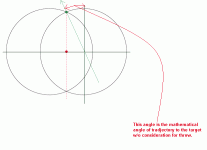Deadon said:Do you then move your eye/head, in relation to the cue, as the aiming point changes? If you didn't, you wouldn't get your overlapping image. It would be distorted unless you moved your eye position.
No, at least I don't think so. I only use the arc - a particular place on that ball edge silhouette - in order to let me know where those two balls have to meet. The arc just happened to be something that my eye can see more readily. I tend to play in a more upright stance - like Danny Diberto's - so I would never actually see the overlap as shown in the diagram, it's just a means of determining where to send the cueball. Since the cueball is closer to the eye, and always appears larger, the view would be distorted even if I was a chin-on-the-cue player.
Once I have determined the place to send the cueball, things become a mishmash of estimations; cloth speed, ball "stiction", cueball swerve and deflection due to english and cueball speed, etc. It's a wonder I can make a ball.
Ken
